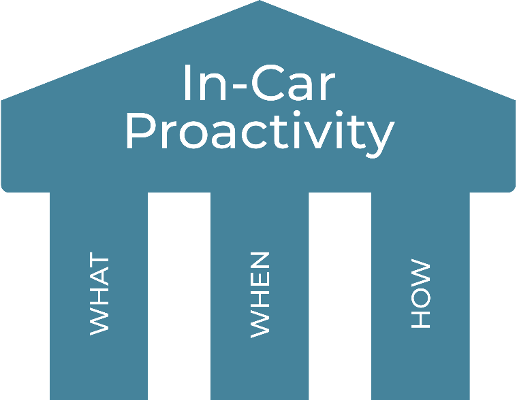By Vanessa Tobisch
In-car voice assistants have been around since the 90s, with Cerence (at that point TEMIC) bringing the first voice-enabled phone calling to the Mercedes S-Class back in 1996. Back then, most drivers weren’t able to experience this type of technology, but today, the landscape is changing. Capgemini predicts that two years from now, 95 percent of drivers will use voice assistants in their car. What sounds like good news to car makers is a two-fold message: An increased demand for in-car voice assistants comes with a lot of homework on the user experience side, which, until recently, most people rated as “needs improvement.” Improving perception of a car’s voice assistant correlates with a 58 percent increased likelihood of subscribing to other services by the respective automotive company. Hence, the modern voice assistant is no longer a nice-to-have add-on in the average car, but rather a critical piece of the driving and car ownership experience.
While traditional user-initiated dialogs have thus far been considered state-of-the-art, today’s modern, proactive voice assistants can provide a completely new spectrum of what will be possible in the car. The concept of proactivity not only offers a valid workaround for car manufacturers facing speech recognition issues for complex user requests, but also enables drivers to discover features and functionalities that have been implemented years ago but have never reached them. While this is a hot topic, its realization is fairly complex. Three pillars are crucial to consider when designing for modern in-car proactivity: the what, the when, and the how. What do we want to be proactive about, when is the right time to be proactive, and how do we present the information to the drivers? Let’s take a closer look.

The Proactivity Framework contains three main questions to answer and built upon: what, when and how to be proactive.
The WHAT
Statistics show that over the past decades, advanced driver assistance systems (ADAS) such as braking and lane keeping assistants or blind spot warnings have led to significantly decreasing numbers of accidents (e.g. Summary by Injury Facts or this press release from Daimler). Proactive alerts ranging from driver safety to infotainment are the next logical step to go further down the path of continuously decreasing accidents.
For example, proactively checking in with a driver after an accident or alerting drivers for expected and unexpected maintenance issues such as a critical oil fuel status, tire pressure levels, annual check-ups or detected sirens are just a few examples of useful in-car proactivity that enhances driver safety.
On the infotainment side, various studies show that the average drivers are not aware of what features their cars actually have, using only a very limited amount of speech controls. Cerence DRIVE Lab studies revealed a diverse yet unambiguous emotion map shortly after drivers bought a new car: there is a feeling of excitement to start with that is quickly followed by reported feelings of confusion, frustration, and lastly, resignation.

Why did I buy this car again??
Simply stated, drivers don’t always understand how to interact with their cars, putting them at a deficit when it comes to learning new features and leaving them wondering why they paid for something they don’t know how to use. While developers and product managers have spent countless hours developing the next functionality, the low level of discoverability of features hinders the anticipated UX boost. The truth is, even today’s systems are capable of so much more than navigating to a destination or making a phone call! It is just hidden and yet to be discovered. This is where the in-car onboarding feature in Cerence Car Life comes in.
Imagine a system that tracks what in-car features you use. Further imagine that it would monitor contextual information of the surrounding environment using vehicle sensors, internally sort potentially relevant features for you with an underlying AI, and finally, proactively approach you when, for example, you are driving on a highway: “You are about to face congestion in two minutes. Shall I tell you more about my smart traffic assistant?”

Proactive in-car onboarding enhancing UX.
Giving you the information you need to understand what the built-in traffic assistant can do for you and how to activate it, you are good to use it around the time when you enter traffic congestion. Seamlessly, you have learnt a new skill. No looking it up in the manual, no how-to-guide on YouTube with the annoying ads upfront. The car just shows you what it can do – simple.
The WHEN
In a smart home setting, finding a good time to interrupt a user’s day with proactive notifications is beneficial. In the car, it becomes an unnegotiable necessity. The wrong timing might distract drivers when they need to concentrate or interrupt a social moment in the car, causing frustration. This decreases not only the overall user experience but might even lead to manual system shutdown of annoyed drivers who put a lot of money into their cars and expected a sophisticated service. Smart voice assistants will have a mechanism in place that continuously monitors the environments inside and outside of the car, taking into consideration previously gained knowledge and using embedded and cloud information to ensure the right timing to be proactive. This means deciding what information is critical for safe driving and reacting with the appropriate call-to action or de-escalation behaviour. This also means deciding if the information is immediately relevant to drivers and will add value to their journey in a user-centred, AI-based evaluation that takes place in real-time.
Looking at our in-car feature teaching example in Cerence Car Life, a family driving in a car with kids will have different needs than a working person who just returns home after a stressful day, looking for some relaxation and entertainment to ease their way into home time. Similarly, young, nervous drivers who have been driving for less than a year will have different needs for learning about advanced driving assistance features than experienced daily drivers on their commute. Smart algorithms are the basis of detecting meaningful moments that increase driver satisfaction throughout the drive, finding the right balance between user and system-initiated conversations when the time is right.
The HOW
While the how – as in the modality choice – might be a logical result of the various combinations of what to be proactive about and when, the challenge for a solid framework is to cluster those modality combinations. Some information is immediately relevant and urgent in drivers’ perceptions and might be verbally addressed, while other information might be better off with a single audio signal or with being requested by the user in the car in a non-proactive way. Groups of different driver safety levels need to be laid out and mapped to visual, auditive, non-verbal, and verbal proactivity concepts, or a combination thereof. The same exercise needs to be done for any infotainment content that is connected to proactivity, carefully establishing a way to understand the mental model of each driver. The main goal here is to answer the question of what drivers consider relevant at a specific point in time and how intrusive the notification concept underneath should work. And yet again, this is where AI comes in, detecting user patterns and learning what information should be presented in which way while maintaining an elaborate balance between functionality and privacy of drivers and between too many (and therefore annoying) proactive notifications or too few, always keeping in mind driver safety.
It is exciting to see where this in-car proactivity journey leads and what possibilities it will provide in the near future, further enhancing both user safety and satisfaction. Just as with automation, carmakers will still have to overcome some hurdles to reach a solid framework that provides the best experience to drivers, considering the what, when and how along the way. As for me, I am looking forward to it.
For more information on Cerence Car Life, visit https://www.cerence.com/cerence-products/applications/car-life.
